Volume 129 - September 2017
We will now bring you the news from Iwate's reconstruction.
Support for Iwate's Reconstruction - Gantry crane donated from Osaka now in operation

In supporting Iwate’s path to reconstruction from the Great East Japan Earthquake and Tsunami, Osaka Prefecture donated a gantry crane which began its operation on September 23rd (Sat).
A gantry crane, also called a portal crane, is a massive and heavy crane used to load and offload large-sized containers. This type of crane is the first to be used in one of the harbors here.
The donated crane is 56 meters in height (76 meters when the boom is extended) and weighs 600 tons. It can carry up to 25-40 containers in one hour which is more than three times of the current cranes operating in the Kamaishi harbor.
Since the disaster, Osaka Prefecture has been very supportive to Iwate by dispatching a number of its prefectural employees for aid. This donation of the crane was made possible with help from these employees.
At the donation ceremony held at the Osaka Prefectural Office on August 3rd (Thu), Osaka Governor Matsui presented a replica of a key (for the crane) to Governor Tasso. “It is our great pleasure to assist the reconstruction and further development of Tohoku,” he commented.
At the Kamaishi harbor, regular container shipments from direct foreign trade will begin this autumn. Handling large container ships will be easier with the addition of the gantry crane, and altogether, it is expected to have a large effect on the distribution of goods in the prefecture.
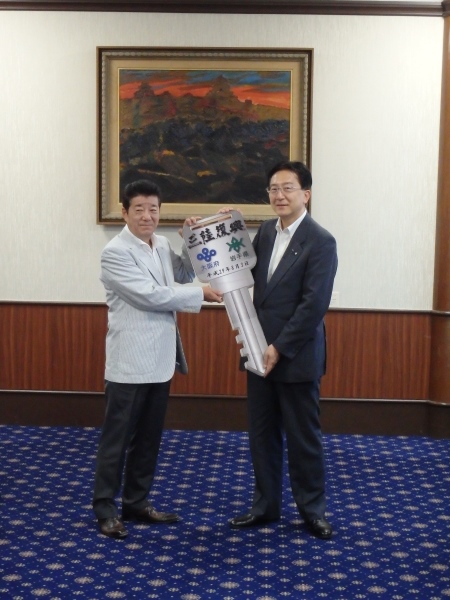
Results from the Iwate Reconstruction Watchers Survey #2 for 2017
Iwate Prefecture conducts the Iwate Reconstruction Watchers Survey in order to periodically measure Iwate’s reconstruction progress from the Great East Japan Earthquake and Tsunami. The survey targets people living or working in the disaster-affected areas, and is conducted once every six months.
Here are some key points based on results from the second survey conducted in July 2016.
Have the lives of the survivors recovered?
“Fully” or “Mostly” Recovered: 83.5% (Previously: 78.6%)
There were many who’ve felt their lives improved since the reconstruction of the damaged roads and after moving into permanent public housing. It became easier to see a clearer image of a full recovery. However, there were some who voiced concerns about the future activities of the local community.
Have the local economy recovered?
“Fully” or “Mostly” Recovered: 62.8% (Previously: 53.6%)
Gradual improvements in the local economy are now being left thanks to the completion of large shopping center. There were still concerns about the shortage of labor and whether market routes can be secured.
Are you satisfied with the measures to reduce disaster risk?
“Satisfactory” or “Mostly Satisfactory”: 50.4% (Previously: 45.9%)
Many praised the completion of the seawalls, housing facilities, and the road reconstruction, and felt they are getting closer to a full recovery. But some were dissatisfied with the difference in reconstruction progress between regions. Also, there were some who felt the need for a stronger education in disaster awareness.
What are the “New Tohoku” Reconstruction Awards?

The Reconstruction Agency is working to create a “New Tohoku” to act as a model for the rest of the country and the world. For this, they use the skills and know-how of local people to push forth its initiatives. Honoring these citizens for their contributions will promote these efforts more widely, both in and outside of the disaster regions.
Potential candidates: Charities, businesses, universities or private individuals who have contributed towards a “New Tohoku” over the course of the last year.
Application deadline: October 1 - November 20, 2017
Residents vote on the building design for the new Otsuchi train station

The JR Yamada Line, from Miyako to Kamaishi (55.4 kilometers) was damaged so badly in the earthquake and tsunami that its route became impassable. Plans have been made to transfer the service to the Sanriku Railway (a joint public-private railroad) and to reopen the train line in spring of 2019.
In preparation for this, a poll was held for two days, from August 11th (Fri) to the 12th (Sat), at the Seaside Town Mast Shopping Center (in Kozuchi, Otsuchi town) to vote on a design for the Otsuchi train station also scheduled to be rebuilt.
This event was arranged by Otsuchi Town to raise expectations for the new train station by allowing many town residents to vote on the design. The building design with the most votes was chosen.
Three designs were displayed: a gourd-shaped island design based on the Horai-jima (known to have inspired a famous Japanese TV show) in Otsuchi Bay, a magistrate’s office design based on a similar one during Edo period, and an ocean- themed design with waves and the sunrise. 1,701 people participated in the vote. Participants were instructed to place a sticker on their favorite design. In the end, the gourd-shaped island design won with 919 votes.
Construction of the new station is scheduled to start in July 2018 and estimated to finish by December of the same year.
Restoration of the School Yard Completed at the Noda Middle School
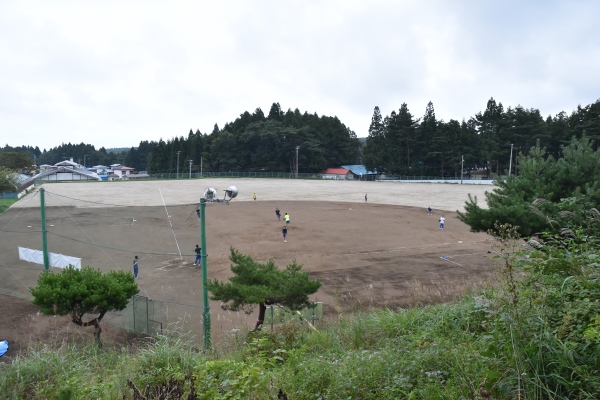
At Noda Middle School (Principal Kikuchi, 96 total students) located in Noda Village, temporary housing units were built in the schoolyard in May 2011 to accommodate the survivors of the tsunami from the Great East Japan disaster. 112 households, the highest number in town, had initially moved into the temporary units.
The school was unable to use the schoolyard for the duration, and dismantlement of the temporary housings began in August 2016 once residents began to recover and rebuild their houses, and construction of a new public housing for survivors was completed. When all work ended on August 22, 2017 (Fri), a final inspection was conducted by construction personnel and contractors of the prefecture.
Now that the schoolyard is back, the children can continue to have a better and more enjoyable school environment. The restoration of the schoolyard also marked an end to one of the ongoing projects for reconstruction.
Feature

What happened that day? In this section, we will be looking back at the disaster in each coastal town.
Noda Village
- Height of Tsunami:21.4m Noda Bay
- Deaths: 38
- Missing: 0
- Injured: 19
- Destroyed Buildings: 479
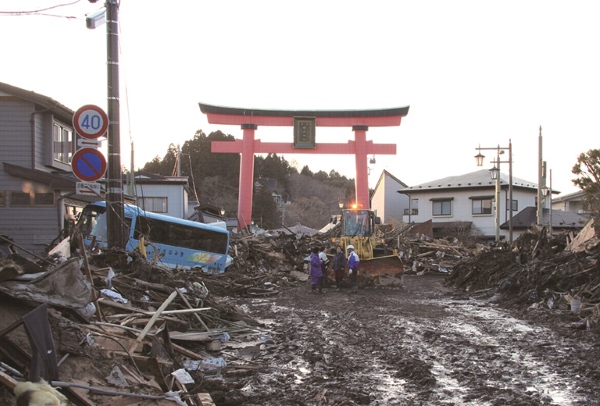
Overview of the Damage
50 percent of the damage in Noda Village was agricultural and forestry related, caused by the catastrophic waves that poured into town from the Noda fishing harbor. The damage rose to 2.92222 billion dollars.
The second heavily hit areas were buildings such as the prefectural office, businesses, and residential buildings with up to 1.68932 billion in damage.
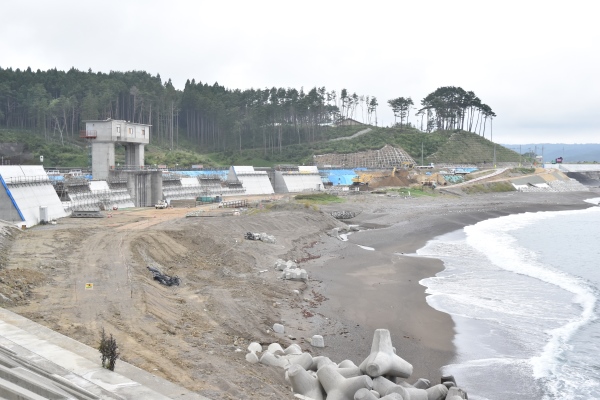
How everyday disaster awareness saved children’s lives
The tsunami swept away the Noda Childcare Center. However, all 81 children and 14 staff at the center on that day survived.
Realizing that it would be difficult to escape the tsunami within 15 minutes before its supposed impact, the center had purchased an escape stroller in advance that can fit ten children for easier evacuation. In addition, regular disaster awareness, such as reexamining escape routes, lead to no casualties from this childcare center.
The Three Great Noodles of Northern IWate Commercialized

Fudai Village, Karumai Town, and Hirono Town located in the northern area of the prefecture cooperated to develop a new product called the Three Great Noodles of Northern Iwate. Kelp, wild sesame, and spinach (region specific ingredients of each location) were mixed with the flour and kneaded into the noodles. The finished products were placed on the shelves of select stores in Morioka (such as Nanak and Lala Iwate) from August 11th (Friday).
The noodles were created under the supervision of Megumi Onodera, Iwate Prefecture’s professional food advisor and a cooking specialist, to encourage agricultural diversification and to develop a new brand of food to represent the northern regions.
Each noodle has unique characteristics to enjoy. The Fudai Kelp Ramen will remind you of the sea once you bite into the smooth noodles. The chewy texture of the Karumai Wild Sesame Cold Noodles are accompanied by the strong, toasty aroma of sesame, and the Hirono Spinach Udon has a pretty green shade and light texture.
Iwate is already known for its Morioka Three Great Noodles (Jajamen, Reimen, and Wanko soba). There are high hopes for these noodles to attract more attention to the prefecture and become the second Three Great Noodles of Iwate.
A new Japanese sake made from the rice of the disaster-affected prefectures
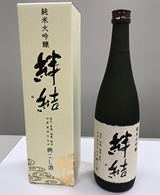
Four disaster-affected prefectures - Iwate, Miyagi, and Fukushima from the Great East Japan Earthquake and Tsunami in Tohoku and Kumamoto from the earthquake in 2016 - collaborated to brew a new Japanese sake made from the rice brand, “Hitomebore.” The sake was named “Kiyu,” and expresses hopes of reconstruction and gratitude towards the great deal of support received during the disaster.
It made its debut and was on sale for a limited time at the “2017 Career Boost Fair” during the Tokyo International Forum held in Chiyoda, Tokyo from August 22nd (Tue) to 23rd (Wed).
The fair was hosted by the Johnan Shinkin Bank (a credit union in Shinagawa, Tokyo) in cooperation with other banks within the country to aid reconstruction efforts and to bring a bright and positive future for Japan. This is the sixth time for this fair to be held with the first held back in 2012. A segment of the fair was dedicated to promote and boost up Japanese sake breweries, which was proposed by Johnan Shinkin Bank and made possible with the help of fifteen credit unions within Iwate, Miyagi, Fukuoka, and Kumamoto Prefectures.
Kiyu is categorized as the highest grade of sake (junmai daiginjo). It was brewed at the Akebono brewery in Aizu Bange-cho, Fukushima. The meaning of the name implies a hope that people across the country will create a strong bond, and so you can enjoy its unique fruity taste in one gulp. One 720ml bottle costs 2,600 yen (tax not included). 200 yen from each bottle sale will be donated to the disaster-affected prefectures.
The 9th Autumn Sanriku Railway "Santetsu" Festival (Kuji)

This year will be the ninth time for this festival, and there will be several stage events at the festival site in Kuji City. In addition, participants will have a chance to ride on a draisine, or rail bikes (a pedal-powered light vehicle on the railway tracks to transport crews and equipment used for maintenance), and a competition to time the fastest person to tug a real train car up three meters. It’s a festival that can be enjoyed, not only by fans of the Sanriku Railway, but also by the local people of the area.
Date: 11/5 (Sun)
Time: 10:00–15:00 (Tentative)
Admission: Free
Location: Kuji City Kawasaki Town - Sanriku Railway North Rias Line
Operation Base & Rail Yard
Inquiry
Sanriku Raikway North Rias Line Operation Department
Phone: 0194-52-3411
Explore Sanriku! Farmer's Market "Hama-no-Eki Omoto-Aidokan" Opens
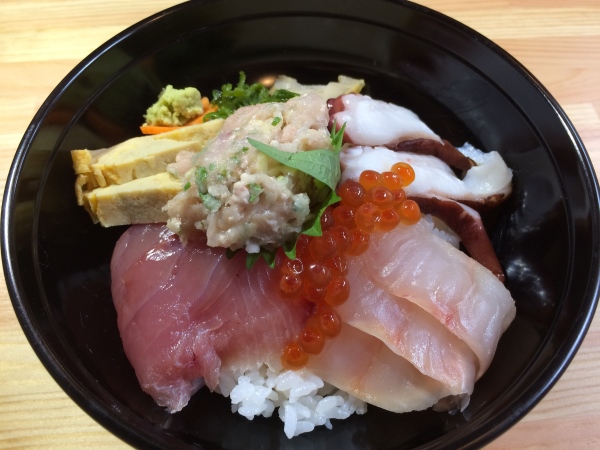
Lately lots more people are looking to buy products directly from the local farmers and fishermen. The Hama-no-Eki Omoto – Aidokan is a road stop and fish market where fresh fish are sold by the local fishermen. Agricultural and specialty products can be bought here as well.
On September 3rd (Sun), a farmers’ market called “Hama-no-Eki Omoto – Aidokan” opened in the district of Omoto, Iwaizumi Town. The word “aidokan” is a dialect of Iwate meaning “Let’s go together”.
The market corner boasts a variety of seafood, and its freshness is guaranteed because they are brought directly from local fishermen or hauled from stationary net boats operated by the local fisheries cooperative.
At the dining facility, you can eat unique local dishes such as the seared Donko fish with its liver still inside, the Ryuko Kaisen bowl full of rich locally obtained seafood, the Omoto-hama Ramen with a delicious aroma of the sea since heragani (crab) is used as a soup base, and the popular Mekabu soba with the mekabu (the root part of the wakame seaweed) as a topping.
Markets are scheduled on every last Sunday of the month, making it an ideal spot to stop over on your trip to the Sanriku coast.
Address: Iwate Prefecture Shimoheigun Omoto 6-25
Business Hours:
- Market Corner: 8:30-18:30 (Will close 17:30 November - March)
- Dining Corner: 11:00-15:00 (Last Order 14:30)
※ Dining corner is open on weekends, holidays, and obon season
※ Advance reservation is must on weekdays
Inquiry: Phone: 0194-32-3288
Feature

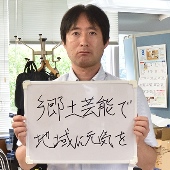
Many young people are diligently helping the affected area of Sanriku move toward a full reconstruction. The section “People for Sanriku’s Future” introduces these young people and their powerful feelings.
Click the link to read about Yasuyuki Ishiguro and how he works to preserve the local folk dance of Iwaizumi called Nakano Nanazumai.
Casualties and Damage in Iwate (as of August 31, 2017)
- Deaths: (direct) 4,672, (indirect) 463; Missing: 1,121
- Buildings destroyed (residences only, total/partial): 26,077
Thank you for all of your support! (as of August 31, 2017)
Donations for survivors: Around 18.57027 billion yen (95,029 donations)
Donations for reconstruction projects: Around 19.86823 billion yen (8,287 donations)
Iwate Learning Hope Fund donations: Around 9.08710 billion yen (20,447 donations)
※ This fund is to assist in the study and daily life of affected
children by encouraging sport and study activities.
Contact
News from Iwate’s Reconstruction, Volume 129. September 25th, 2017.
Published by the General Affairs Division, Bureau of Reconstruction, Iwate Prefecture.
Phone: 019-629-6925
Editing & Printing: SYNAPSE
*News from Iwate's Reconstruction Volume 130 will be published on October 25, 2017.
PDFファイルをご覧いただくには、「Adobe(R) Reader(R)」が必要です。お持ちでない方はアドビシステムズ社のサイト(新しいウィンドウ)からダウンロード(無料)してください。
このページに関するお問い合わせ
Office of International Affairs, Department of Homeland Promotion
(020-8570) 10-1 Uchimaru, Morioka City, Iwate Prefecture, JAPAN
Phone number:019-629-5765 Facsimile:019-629-5254
You can access our question form here.

